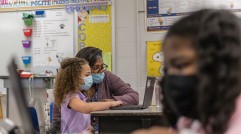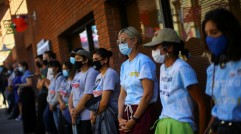HIV Infection Diagnoses Spike Among Latino Men Engaging in Male-to-Male Sexual Contact
The Centers for Disease Control and Prevention (CDC) produced a report confirming that new diagnosis of HIV infection has risen sharply among Latino men who have sex with men (MSM), despite overall declines in infections among U.S. Latinos during the same period.
The report showed HIV disproportionally affects Hispanics/Latinos. In 2013, the HIV occurrence rate was nearly three times that of non-Hispanic whites, according to Kristen Mahle Gray from CDC's National Center for HIV/AIDS, Viral Hepatitis, STD, and TB Prevention (NCHHSTP). Mahle and colleagues published the findings in the Oct. 9 issue of the Morbidity and Mortality Weekly Report.
Fortunately, the overall rate of HIV infection diagnoses decreased from 28.3 per 100,000 in 2008 to 24.3 in 2013 among U.S. Latino adults. Nonetheless, diagnoses of HIV infection remained high among U.S. Latino men, and it's attributed to male-to-male sexual contact. There was a 16 percent increase in the number of diagnoses among Latino men engaging in sex with other men.
The report indicated more work needs to be done to effectively reach Latinos or Hispanics, as indicated by the higher rate of HIV infection, and higher risk of acquisition and transmission. Targeting Latino subpopulations with preventative campaigns is vital; there's an express need to target individuals who inject drugs and men who have sex with men. Also, tailored HIV prevention strategies should include prioritizing testing, treatment and care, education, and the availability of protective interventions.
The increases among Latino men who have sex with other men parallels an overall increases in new infections among all U.S. men who have sex with other men, which suggests a resurgence in that subgroup. Diagnoses have decreased in all other transmission groups. Behavioral risk factors for HIV in Latinos varied on the basis of birthplace; however the study admitted a possible misclassification of Hispanics or Latinos and missing birthplace information for 16 percent of Hispanic or Latino participants.
"CDC and its partners are pursuing a high-impact prevention approach to maximize the effectiveness of current HIV prevention methods," the study authors say.
"Example activities include providing technical assistance to health departments and community-based organizations to deliver effective prevention interventions to Hispanics or Latinos, and supporting testing projects and campaigns that focus on Hispanics or Latinos."
Subscribe to Latin Post!
Sign up for our free newsletter for the Latest coverage!














